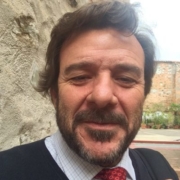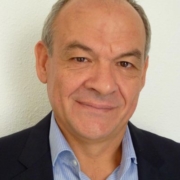Ann Daly
ESPT President
Welcome to the website of the European Society of Pharmacogenomics and Personalised Therapy (ESPT)!
ESPT is the primary professional scientific non-profit society for pharmacogenetics and pharmacogenomics in Europe, founded in 2011. ESPT aims at enabling the integration of pharmacogenomics and pharmacogenetic information into today’s health care. Most important activities are the organized yearly scientific meetings (Seville 2019, Catania 2017, Budapest 2015, Lisbon 2013, Bled 2011) and summer schools (Kiel 2020, Geneva 2018, Belgrade 2016, Rome 2014, Ljubljana 2012) to facilitate ESPT mission and vision .
The Society has an Executive Board representing pharmacogenomic professionals. The Society consists of four Divisions : Clinical Implementation, Research, Education and Communications. In addition, the Society is proud to have its own journal: Drug Metabolism and Personalized Therapy, DMPT. The society reaches over 600 member, consisting of individual members, Research Groups, National Pharmacogenomics/genetics Societies, Corporate members and a Scientific Advisory Board . Benefits of joining the Society are that members get access to DMPT, to ESPT members-only page and get great opportunity to join ESPT Conferences and Summer Schools.
One of the important goals of our society is to bring together all relevant stakeholders to exchange the latest information on pharmacogenomics and pharmacogenetics, to stimulate new research and collaborations in this field and to facilitate implementation of pharmacogenomics/pharmacogenetics into clinical practice.
Do you want to be a part of this exciting Society, and contribute to the ESPT Mission and Vision? Then do not wait any longer, and join ESPT ! We are looking forward to have you on board as an ESPT member and meet you soon at one of our activities!
Kindest regards
ESPT MISSION
OUR MISSION IS TO CONTRIBUTE TO SAFER AND MORE EFFICENT USE OF DRUG THERAPY FOR EVERY PATIENT IN EUROPE, UTILIZING THE POTENTIAL OF PHARMACOGENOMIC* INFORMATION.
Aims of ESPT
ESPT aims to stimulate the translation of pharmacogenetics/genomics research into clinical use, by:
- Supporting clinical implementation both on a national and clinical laboratory level
- Stimulating exchange of information between stakeholders
- Facilitating research
- Providing and structuring education
- Serving as a partner for industry
Giving input to regulators and policy makers in the field of personalised medicine*
* Pharmacogenomics
Pharmacogenomics corresponds to theapplication of the systematic screening of the human genome for the search of genetic markers sensitive to the action of the drugs either at the level of the cellular or molecular targets,at the level of the drug metabolismor even at the level of the pathological pathways involved.
* Personalized Medicine
Personalized Medicine refers to a medical model using molecular profiling for tailoring the right therapeutic strategy for the right person at the right time, and/or to determine the predisposition to disease and/or to deliver timely and targeted prevention
ESPT STRATEGIC PLAN
The first, strategic plan is intended to achieve a number of principal objectives, with the priorities and tactical implementation being guided by the ESPT Membership.
These internal and external changes are all intended to maintain ESPT as a valid and credible resource of expertise for the improvement of patient care through laboratory medicine.
PRINCIPAL OBJECTIVES
-
To improve and maintain the multidisciplinary and international leadership of ESPT in specific Pharmacogenomics (PGX) biomarkers activities. PGX is the best example of personalized therapy and personalized medicine.
To ensure that its standardization and research activities are more oriented towards the patient and towards promoting the health and well-being of the individual. -
To ensure consistency between its activities and the stated expectations of the ESPT members, recognizing the needs of both developed and developing countries. To increase the number of National Societies and Networks.
-
To develop and maintain ESPT communications, to promote publications and products from ESPT, including recommendations, guidelines, consensus reports, commentaries, and to set up joint promotion activities with other European and international organizations.
-
To establish collaborations, joint meetings and projects with European and international organizations having interest in the field of PGX and – personalized medicine.
-
To promote ESPT through international and regional congresses.
-
To promote Members’ activities.
-
To encourage scientific and professional development of individuals in Research groups and the recruitment of new members and experts to ESPT operating units.
-
To develop and maintain Public Relations.
-
Each new ESPT Executive Board revisits and interprets these principal objectives, so that they are fresh and relevant to current issues, challenges and opportunities.
-
The result is a series of specific strategic objectives for the period of an Executive board.
EXECUTIVE BOARD MEMBERS
Mikko Niemi
ESPT President
Ann Daly
Past President
Vita Dolzen
General Secretary
Sanja Stankovic
Treasurer
Tiffany Morris
Corporate Members Representative
Ron van Schaik
Board Member
Adrian Llerena
Board Member
Espen Molden
Board Member
Erika Cecchin
Member
PAST PRESIDENTS
PROF. GÉRARD SIEST (2012–2016)
Siest Prof. Gérard Siest was among the founding members of ESPT in 2011, and was an important inspiratory and driver of the society. He served as ESPT president from 2012–2016. Under his leadership, ESPT gained worldwide visibility and became an important scientific stakeholder in the field of pharmacogenomics and personalised medicine.
Prof. Siest was emeritus professor of molecular biology and biochemical pharmacology at the Faculty of Pharmaceutical Sciences and former director of the postgraduate course in Biochemical Pharmacology at the University Henri Poincaré in Nancy, France.
He was also the founder and head of the clinical laboratory and research group of the “Centre de Médecine Preventive” in Nancy for 37 years (1968-2005). As an extremely hardworking person Prof. Gérard Siest was well known to the scientific community as author of more than 800 publications in peer reviewed journals and his work was honoured by 27 awards from sixteen different countries.
He was strongly involved in activities of many international and european professional societies, and served as President of IFCC (1991-1996). Prof Siest also was active in many editorial boards, and had an important role in the ESPT journal DMPT.
Prof. Dr. Ron H.N van Schaik (2016-2020)
Prof Dr Ron HN van Schaik was among the founding members of ESPT in 2011, and succeeded Prof Gerard Siest. Prof van Schaik is the second ESPT President, serving from 2016–2020. Under his leadership, ESPT maintained worldwide visibility in the field of pharmacogenomics and personalised medicine. Under his presidency, the 2017 Catania and 2019 Seville ESPT Congresses were organized, as well as the 2018 ESPT Summerschool in Geneva and he achieved 5 National PGx Societies to join ESPT.
Prof. Dr. Ron H.N. van Schaik studied Chemistry at Utrecht University, receiving his PhD in 1992. After a 4 year post-doc at the Dept. Endocrinology, Erasmus MC Rotterdam and a 1 year post-doc at the Daniel den Hoed Cancer Center, he joined the Dept. Clinical Chemistry at Erasmus MC, receiving his Dutch and European registration (EuSpML) in April 2003. Prof van Schaik continued to work at the Dept Clinical Chemistry, becoming an Associate Professor in 2008 and a Full Professor Pharmacogenetics in 2013. He is now Director of the IFCC Expertcenter for Pharmacogenetics. Prof van Schaik is active in National and International committees on Pharmacogenetics (IFCC Task Force PGx (chair), IFCC cfDNA Working group (chair), AACC Personalised Medicine Division (founding member), AMP Expertgroup PGx, PGRN (founding member), IATDMCT PGx Committee (chair), IUPHAR PGx Committee, NVKC Molecular Biological Diagnostics (chair)), KNMP/Dutch PGx Working Group and the EMA PGx Working group.
H-factor: 72 (Google Scholar 2020)
Prof. Vangelis Manolopoulos (2020-2022)
Ann Daly (2022-2024)
PAST AND PRESENT BOARD MEMBERS AND TERMS OF OFFICE
| MEMBER | COUNTRY | 1st TERM | 2nd TERM | 3rd TERM | REMARKS | ROLE | |||
| 1 | Gerard Siest | FRA | 2012-2016 | – | – | Founding Member | President (2012-2016) | – | |
| 2 | Ron van Schaik | NED | 2012-2016 | 2016-2022 | 2022-2026 | Founding Member | President (2016-2020) | Past-president (2020-2022) | |
| 3 | Vangelis Manolopoulos | GRE | 2012-2016 | 2016-2020 | 2020-2024 | Founding Member | President-elect (2016-2020) | President (2020-2022) | Past President (2022-2024) |
| 4 | Janja Marc | SLO | 2012-2016 | 2016-2020 | Founding Member | General Secretary (2012-2016) | – | ||
| 5 | Adriano Henney | UK | 2012-2014 | – | – | Founding Member | Treasurer (2012-2014) | – | |
| 6 | Sofia Siest | FRA | 2012-2016 | 2016-2020 | – | Founding Member | Treasurer (2014-2016) | – | |
| 7 | George Patrinos | GRE | 2012-2014 | – | – | Founding Member | – | – | |
| 8 | Adrian Llerena | SPA | 2012-2016 | 2018-2022 | 2022-2026 | Founding Member | – | – | |
| 9 | Maurizio Simmaco | IT | 2013-2017 | 2017-2021 | – | – | Treasurer (2018-2021) | – | |
| 10 | Ingolf Cascorbi | GER | 2013-2017 | 2017-2021 | Treasurer (2016-2018) | ||||
| 11 | Csilla Sipeky | FIN | 2016-2020 | 2020-2024 | – | – | – | – | |
| 12 | Sanja Stankovic | SER | 2016-2020 | 2020-2024 | 2024-2026 | – | Secretary (2016-2024) | Treasurer (2024-2027)- | |
| 13 | Marc Ansari | CH | 2014-2018 | 2018-2022 | – | – | – | – | |
| 14 | Ann Daly | UK | 2020-2024 | 2024-2026 | – | President (2022-2024) | Past President (2024-2026) | ||
| 15 | Mikko Niemi | FIN | 2020-2024 | 2024-2026 | – | Treasurer (2021-2024) | President (2024-2026) | ||
| 16 | Peter Jacobs | NL | 2012-2016 | 2016-2020 | Corporate Representative (2012-2020) | ||||
| 17 | Tiffany Morris | UK | 2023-2027 | Corporate Representative (2023-2027) | |||||
| 18 | Vita Dolzen | SLO | 2023-2027 | General Secretary (2024-2027) |
SCIENTIFIC ADVISORY BOARD
WORKING GROUPS
Webinars
(Educational Division)
Vangelis Manolopoulos
Harmonization of PGx testing and PGx guidelines
(Clinical Implementation Division)
Ron van Schaik
Social Media
(Communication Division)
Csilla Sipeky
Ron van Schaik
Marina Festinese
LINKS
PUBLICATIONS
Second International ESPT Meeting – Lisbon, Portugal, 26–28 September 2013: Pharmacogenomics: from cell to clinic (Part 1 and 2). Pharmacogenomics (2014) 15(5), 593–599; Pharmacogenomics (2014) 15(6), 739–744
Conference Scene: Systems medicine, personalized health and therapy. Pharmacogenomics (2015) 16(14):1527-39
Systems medicine, personalized health and therapy. Pharmacogenomics 2015;16(14):1527-39. doi: 10.2217/pgs.15.103. Epub 2015 Sep 24. PMID: 26401575.
Siest G, Auffray C, Taniguchi N, Ingelman-Sundberg M, Murray H, Visvikis-Siest S, Ansari M, Marc J, Jacobs P, Meyer U, Van Schaik RH, Müller MM, Wevers RA, Simmaco M, Kussmann M, Manolopoulos VG, Alizadeh BZ, Beastall G, Németh G.
Progress in pharmacogenetics: consortiums and new strategies. Drug Metab Pers Ther. 2016;31(1):17-23. doi: 10.1515/dmpt-2015-0039. PMID: 26913460.
Maroñas O, Latorre A, Dopazo J, Pirmohamed M, Rodríguez-Antona C, Siest G, Carracedo Á, LLerena A.
4th ESPT summer school: precision medicine and personalised health. Pharmacogenomics. 2019;20(7):471-474. doi: 10.2217/pgs-2019-0008. PMID: 31124416.
Mlakar V, Marc J, Manolopoulos VG, Cascorbi I, Stanković S, Llerena A, Simmaco M, Visvikis-Siest S, Amstutz U, Sipeky C, Meyer UA, Meier-Abt P, van Schaik RH, Ansari M.
4th ESPT Conference: pharmacogenomics and personalized medicine – research progress and clinical implementation. Pharmacogenomics. 2019;20(15):1063-1069. doi: 10.2217/pgs-2019-0095. PMID: 31588876.
Sipeky C, Llerena A, Manolopoulos VG, Pearson E, Mlakar V, Gozzo L, Simmaco M, Marchetti P, Re MD, Stankovic S, Meyer U, Cascorbi I, Ingelman-Sundberg M, Suarez-Kurtz G, Marc J, Katsila T, Paulmichl M, Nofziger C, Ansari M, Drago F, van Schaik RH.
The need of the clinical implementation of pharmacogenetics in European health services for routine drug prescription. What’s next? An urgent clinical unmet need for patients. Drug Metab Pers Ther. 2020;35(4). doi: 10.1515/dmpt-2020-0172. PMID: 34704693.
Taron M, Llerena A, Manolopoulos VG, Rodriguez-Antona C, Stankovic S, van Schaik RHN.
Recommendations for Clinical CYP2D6 Genotyping Allele Selection: A Joint Consensus Recommendation of the Association for Molecular Pathology, College of American Pathologists, Dutch Pharmacogenetics Working Group of the Royal Dutch Pharmacists Association, and the European Society for Pharmacogenomics and Personalized Therapy. J Mol Diagn. 2021;23(9):1047-1064. doi: 10.1016/j.jmoldx.2021.05.013. Epub 2021 Jun 10. PMID: 34118403
Pratt VM, Cavallari LH, Del Tredici AL, Gaedigk A, Hachad H, Ji Y, Kalman LV, Ly RC, Moyer AM, Scott SA, van Schaik RHN, Whirl-Carrillo M, Weck KE.
TPMT and NUDT15 Genotyping Recommendations: A Joint Consensus Recommendation of the Association for Molecular Pathology, Clinical Pharmacogenetics Implementation Consortium, College of American Pathologists, Dutch Pharmacogenetics Working Group of the Royal Dutch Pharmacists Association, European Society for Pharmacogenomics and Personalized Therapy, and Pharmacogenomics Knowledgebase. J Mol Diagn. 2022;24(10):1051-1063. doi: 10.1016/j.jmoldx.2022.06.007. Epub 2022 Aug 2. PMID: 35931343.
Pratt VM, Cavallari LH, Fulmer ML, Gaedigk A, Hachad H, Ji Y, Kalman LV, Ly RC, Moyer AM, Scott SA, van Schaik RHN, Whirl-Carrillo M, Weck KE.
The Sixth European Society of Pharmacogenomics and Personalised Therapy Congress. Pharmacogenomics. 2023;24(5):243-246. doi: 10.2217/pgs-2023-0013. Epub 2023 Apr 4. PMID: 37014361.
Van Schaik RH, Manolopoulos VG, Daly AK, Niemi M, Zukic B, Patrinos GP, Primorac D, Swen JJ, Ingelman-Sundberg M, Morris T, Molden E, Müller D, Pavlovic S, Russmann S, Ansari M, Henricks LM, den Broek WV, Florindi F, Bozina N, Akin D, Christrup L, Llerena A, Sipeky C, Stankovic S.
STATUTES
Approved in Belgrade in October 2022
Article 1. – Name
The Society, established under the French law dated 1st July 1901 and the decree dated 16th August 1901, is called:
“Société Européenne de Pharmacogénomique et Thérapie personnalisée – European Society of Pharmacogenomics and Personalised Therapy” (ESPT).
Article 2. – Objective
The European Society of Pharmacogenomics and Personalised Therapy is a non-profit making organisation. Its objective is to promote exchange of knowledge and facilitate education, training and research in pharmacogenomics and personalised therapy, in order to produce quality-controlled information for applications in clinical practice health care providers and patients. It aims to facilitate contact between all those sharing its objectives, in particular those working in Europe. The Society will encourage and endeavour to integrate fundamental multidisciplinary approaches to research and transform them into clinical benefits, both for professional training and education of the general public, in all the areas of human pharmacogenomics, clinical pharmacology, laboratory medicine and personalised medicine.
Article 3. – Life-span
The Society has been founded with an unlimited life-span.
Article 4. – Registered address
The registered address of the Society is 30 rue Lionnois – Présidence de l’Université de Lorraine – UMR INSERM U1122 ; IGE-PCV– 54000 NANCY – FRANCE
The Executive Office and corresponding address is located at Via Carlo Farini, 81, 20159, MILAN, ITALY.
Article 5. – Members of the Society
There are 7 categories of members.
5.1. Individual (full member)
Membership will be open to any person working in the pharmacogenomic and personalised medicine field, preferably, but not exclusively, based in a European country.
5.2. Student (full member)
Students, including PhD students are included in this category (under 35 years old).
5.3. National organisations (associate members)
The members of national societies, or corresponding networks related to pharmacogenomics, that have agreed by means of a written application by the national society representative and subsequent approval by the ESPT Board to collaborate with ESPT in the name of their society. A national representative full member is in charge of the society members.
5.4. Scientific group (associate members)
It is a category of individual members in the scientific groups. A Scientific Group ESPT full member is in charge of the research group members.
5.5. Corporate member (full member)
Any company involved in the field of pharmaceutics, biotechnology, laboratory medicine or related disciplines may become a corporate member.
5.6. Scientific Advisory Board member (full member)
Experts in the field of pharmacogenomics and personalised therapy proposed by any ESPT member and accepted by the General Assembly. They are nominated for a period of 4 years renewable.
5.7. Honorary member (full member)
This distinction is awarded to those who have made an exceptional contribution to the field of pharmacogenomics and personalised therapy.
Collaboration with European and International Institutions
ESPT will sign agreement with European and International Institutions, foundations, research institutes and organisations working in the field for avoiding overlapping activities.
Article 6. – Subscriptions
Individual full members, students, corporate members, associate and national society members will pay an annual subscription, the amount of which will be determined by the Executive Board. The subscription for students may be set at a lower amount than that of other members.
Subscriptions will be waived for honorary and scientific advisory board members.
Subscriptions are given in euros, payable at the beginning of each civil year for each paying membership category.
Article 7. – General provisions
7.1. Admission
To join the Society, an applicant can apply for membership through the ESPT Executive Office. Membership can, by exception, be denied by the Executive Board in case of serious matters, to be expressed in writing and to be approved by the General Assembly.
7.2. Loss of membership statutes
Membership of the Society may end:
- By voluntary resignation;
- By death;
- By the dissolution, closure or merger of an organisation that is a member;
- By in arrear of payment annual subscription for two consecutive years.
Article 8. – Activities
The Society organises, co-organises and/or supports meetings, symposia, conferences and other scientific meetings as well as educational programs in order to exchange information for applications in clinical practice in the field of pharmacogenomics and personalised therapy. A major event is the Society’s congress, which will be held either annually or, when appropriate, biennially. A General Assembly will take place during this event. Other activities contributing to the Society’s objectives may also be undertaken, such as participation in grant applications, clinical trials, multi-site trials, evaluation of biomarkers, drawing up and preparing critical independent expert opinions, guidelines and recommendations appropriate to the Society’s areas of interest.
Article 9. – Publications
The Society will aim to publish the programs of its congresses and abstracts of the presentations. The Society will also aim to publish its committees’ reports, and directives and recommendations after ratification by the Executive Board. At present, the journal “Drug Metabolism and Personalised Therapy” (DMPT), published by De Gruyter, is the Society’s official journal. The members of the Executive Board will work closely with the chief editor of DMPT and will encourage members of the Society to submit their work to the journal. The Society reserves the right to periodically examine and modify its publication strategies.
Article 10. – The General Assembly
All members in good standing may take part in the General Assembly. A General Assembly may be ordinary or extraordinary. Meetings considered as extraordinary will be those where decisions are to be taken concerning modification of the statutes orwinding up the Society.
A General Assembly will take place at least once every year, either as an in-person or virtual event. The date and place of the General Assembly will be communicated at least 3 months in advance. Notices to members convening a meeting must show the agenda and should to be sent (either by letter or electronic mail) to all members at least 15 days before the meeting. Minutes of a General Assembly will be taken to record decisions taken and acceptance of the budget. They will constitute an official document of the Society.
No quorum is required for an ordinary General Assembly. Decisions taken in an extraordinary General Assembly will be valid if 30% of members in good standing are present or represented. If this quorum is not reached, the extraordinary General Assembly will be reconvened and will constitute a quorum independent of the number of delegates.
Each member in good standing has one vote. A member may give written procuration to vote to another member. One member may not represent more than one other member. If the number of votes is equal, the President, or in case of absence, the President elect, will have the casting vote.
Ordinary decisions are taken by a simple majority of votes. Decisions in an extraordinary General Assembly are taken with a two-thirds majority of the members present or represented.
The General Assembly will approve the budget and the accounts of the Society, elect or dismiss members of the Executive Board and may modify the articles of association or dissolve the Society. The agenda of the General Assembly must include:
- Presentation, by the President or Secretary, of the Society’s activities over the past year
- Presentation by the Secretary on membership status
- Presentation by the Treasurer of the Society’s finances, validated by independent company, to be approved by the General Assembly
- Discussions and decisions concerning the above
- Reports of divisions on their activities
- Presentation of plans and objectives of divisions for the next elective period
- Determination of members’ annual subscriptions
- Approval of the location for the next ESPT Congress and General Assembly
- Any other questions proposed by the Executive Board, particularly broad general policies.
Article 11. – The Executive Board
11.1. The Executive Board is the governing body of the Society and has all the powers necessary to take decisions. It assumes responsibility for all questions, except those specifically reserved by law and by these Articles of Association to the General Assembly, to which it is responsible. The minutes of Executive Board meetings will be recorded to provide a record of activities envisaged and decisions taken. They will constitute official documents of the Society.
11.2. Composition
The Executive Board will be composed of minimum 6 and maximum10 members:
- The President
- The President-Elect and/or the Immediate Past-President
- The Treasurer
- The Secretary General
- Two to four Councillors
- A Corporate Representative
. The Executive Board members should preferably represent various areas of expertise and have a broad geographical location. It will aim to maintain male/female balance.
11.3. Elections and appointments
ESPT members can express their interest in joining the ESPT Board, no later than 3 months before the General Assembly. The Executive Board will select maximum two individuals per vacancy as nominees. The General Assembly will approve Executive Board members by simple majority vote, taking into account the maximum amount of Executive Board members allowed.
The term of office of a member of the Executive Board will be four years. Members of the Executive Board are re-eligible at the end of their term of office. A term finishes at the end of the General Assembly, ruling on the accounts of the previous accounting period and concurrent with the final year of their term of office as administrator.
The President of the Society will have an initial 2 year term, which can be renewed for a further 2 years by approval of the General Assembly by a majority vote. After completion of their term of office, the President becomes Immediate Past-President for a term of 2 years as member of the Executive Board, unless continuity of the Society is at stake, in which an extension for the term of President is possible, to be approved by the General Assembly.
The candidate or candidates for President-elect position originate from the ESPT Executive Board, and need to be approved by the General Assembly.
For the sake of continuity, the Executive Board should include at least a President-Elect or a Past-President. Ideally, a new ESPT President will, in case of a 2×2 year term, have for the first two years a Past-President, and the last two years a President-elect for support.
The Executive Board will choose from its membership a General Secretary and a Treasurer.
In case a member of the Executive Board has been repeatedly inactive in the Society’s affairs, defined as being absent fromexecutive board meetings within a year and/or developing activities in conflict with ESPT as judged by the Executive Board, may be dismissed by a simple majority decision of the General Assembly.
The corporate representative will be selected from nominated candidates by the Executive Board. Corporate members can nominate themselves up to 4 weeks before the General Assembly. Their participation in the Executive Board needs to be approved by the General Assembly.
If a vacancy occurs, the Executive Board can temporarily replace a member or members by co-opting a Society member. Definitive replacement occurs at the next General Assembly. The power of the substitute Board member ends when the term of office of the member replaced would normally have terminated.
If members of the Board, and in particular the President, reach the end of their terms of office without new elections in view immediately, they will remain in office until the next election in order to ensure that the Society always has a body with the power to represent it, manage its affairs and act in its name.
At each General Assembly, new members of the Executive Board may be proposed and elected to maintain a minimum of 6 members. In accordance with article 5, any member of the Society working in the field of pharmacogenomics and personalised medicine is eligible.
11.4. Board meetings
The Executive Board will meet regularly, at least quarterly and at any other time if the President requests it. Meetings will be held virtually with one annual in person meeting. The Executive Board will also meet on written request from 5 of its members. The agenda of the Executive Board must be sent with the notification (as a simple letter or e-mail) to the members of the Executive Board at least 5 days before the meeting with the necessary documents. Each member of the Executive Board has one vote. If there is an equal number of votes, the President or, in case of absence, the President-elect, will have the casting vote. A simple majority is required for decisions.
11.5. Insurance
The Society will have an insurance in place to warrant Executive Board members against financial claims against the Society.
Article 12. Responsibilities
12.1- President
The President chairs the Executive Board and the Society. The President is responsible for carrying out the decisions of the Executive Board and ensuring that the Society functions well.
The President represents the Society in all public affairs. In particular, the President is entitled to act in legal proceedings to defend the name of the Society and as plaintive with the authorisation of the Executive Board. Under the same conditions the President may formulate an appeal.
The President may only come to a compromise with the authorisation of the Executive Board.
The President convenes the General Assembly and the Executive Board as well as the Steering Committee and chairs all the meetings. The President fixes and chairs Executive Board meetings and the General Assembly. At the President’s request, the organisation of these meetings may be initiated or organised by the General Secretary. In the absence of the President, the President-elect or past-President acts as a substitute. In exceptional circumstances, the Executive Board may select another member of the Executive Board to assume the President’s responsibilities until elections can be organised.
Neither the President nor any other person appointed by of being member of the Executive Board may agree to any operation whatsoever, and particularly any financial transaction involving more than 12,000 euros, without the prior agreement of the Executive Board,
The President may delegate in writing some of the powers set out above to another member, an official of the Society or any person that could be considered appropriate.
12.2 President–elect
The President-elect shall:
- Represents the Society in the case of short-term hindrance of thePresident
- Is member of the steering committee
- May assist the President in all tasks
- Automatically becomes President after the President’s term ends
12.3 General Secretary
The General Secretary shall:
- Maintain a member directory of the Society including voting members
- Keep records of meetings of the General Assembly, and Executive Board
- Distribute the agenda for the meetings of the General Assembly at least 15 days
prior to the meeting, and shall distribute the minutes of the meetings not later than
three months after the meeting
- Collect and distribute information with reference to the activities and objectives of
the Society from and to member societies and associations as well as members
12.4 Treasurer
The task of the Treasurer is to render annually a complete financial account and submit a proposed budget to the General Assembly.
Article 13. – Divisions
The General Assembly and the Executive Board may create ad hoc divisions and working groups. The members of these divisions, working groups are appointed for a period of 4 years, which can be renewed by the Executive Board.
The Executive Board appoints the chairs of each division for 4 years. These divisions will prepare reports for the Executive Board and cannot represent the Society without written consent. The composition of the divisions and their objectives will be presented to the General Assembly for approval. The division chairs could be invited as members to the Executive Board. The divisions and permanent committees are currently as follows:
13.1. Education and Training division
This division is composed of full members and/or associate members. The division chair is a full member of the Society and member of the Executive Board. The division coordinates all ESPT training activities and create the necessary working groups.
13.2. Scientific division
This division is composed of full members and/or associate members. The division chair is a full member of the Society and member of the Executive Board .The division coordinates all ESPT Scientific division activities and create the necessary working groups.
13.3. Clinical Implementation division
This division is composed of full members and/or associate members. The division chair is a full member of the Society and member of the Executive Board. The division coordinates all ESPT Clinical Implementation division activities and create the necessary working groups.
13.4. Communication division
This division is composed of full members and/or associate members. The division chair is a full member of the Society and member of the Executive Board. The division coordinates all ESPT public relations and cooperation activities and create the necessary working groups.
Other divisions or committees could be created and validated at the General Assembly.
Article 14. – Committees
Short term committees (2-4 years) may be created for preparing useful recommendations, opinion papers or consensus reports. Those committees could be scientific or educational. Joint committees with other societies may also be created. They are usually composed of a Chairman nominated by the Executive Board and 2 members.
Article 15. – Organisation of Society Meetings
The Executive Board will decide where future meetings will take place. The site suggested must be accepted by the General Assembly.The site chosen for the ESPT Congress must be announced at least 1 year in advance. The Executive Board must seek invitations for the desired locations and select a site. A contract should be signed between ESPT and the organizer of the ESPT congress to ensure the terms of the collaboration.
For each Congress or Summer School, a Congress Organization Committee shall be appointed by the Executive Board. This will chaired by the Society President, or by an Executive Board member with full authorization of the President. Other members may include the President-elect, chair of the Communication Division, chair of the Education Division and the President of the hosting National Society or equivalent person. The chair of the Congress Organisation Committee has approval of the Executive Board to engage in the necessary financial transactions and commitments, exceeding the earlier mentioned €12,000.
The financial and organisational aspects of the organization of the Congress will be assigned to MZ Congressi, Via Carlo Farini, Milan, Italy, unless otherwise decided by the Executive Board.
Article 16. – Vote and elections of the Executive Board
ESPT members can nominate themselves as Executive Board Member, or be proposed by ESPT members, no later than 4 weeks before the General Assembly. Executive Board membership will be granted when the General Assembly agrees by simple majority vote, taking into account the maximum amount of Executive Board members allowed.
Article 17. – Winding up the society
Winding up requires a vote with a majority of 2/3 of the members at an Extraordinary General Assembly at which half of the members are present or represented. If the Society is to be dissolved, its assets will be attributed to the International Red Cross or to other charitable associations.















